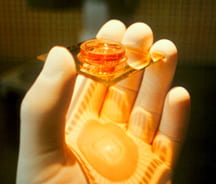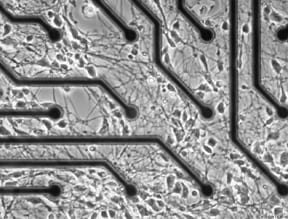We wish to understand the morphological correlates of learning and memory. Systems of cultured neurons provide greatly enhanced access to cellular properties, compared to in vivo systems.

MEA Technology
We use Multielectrode arrays (also called microelectrode arrays) from Multichannel systems on which neurons are cultured for weeks or months at a time. These consist of 60 electrodes made of indium-tin oxide (ITO) or silicon nitride on a glass substrate. Because the multielectrode arrays are transparent, we can observe neuronal morphology, using an inverted microscope, through the bottom of the culture dish. The dish is connected to amplifiers and a computer that allows continuous stimulation of and recording from neurons lying on or near electrodes.
Neuron cultures on MEAs
We use cultures of dissociated neurons from rat embryos, which rapidly form synapses in culture and develop complex patterns of spontaneous activity. By eavesdropping with the ITO electrodes, we can begin to decipher the electrical language that neurons speak. By electrically stimulating groups of neurons with various patterns of “simulated action potentials” we hope to observe morphological changes in the cultured neural networks that might indicate how neurons in living brains change when we learn something new. These might involve changes in synapse number or size, outgrowth or pruning of dendritic and axonal arbors, formation of dendritic spines, or perhaps interactions with glial cells.

By studying the basics of how electrical activity influences neuronal morphology, and how these changes in morphology then alter the networks’ electrical properties, we will provide useful parameters for computer models of neural networks. This will allow us to develop artificial learning systems that take advantage of some of the clever adaptations that have evolved over the ages in natural neural systems.
How to Culture, Record and Stimulate Neuronal Networks on Micro-electrode Arrays
We published a how-to video on the Journal of Visualized Experiments: click here
References
- Further reading for Multielectrode arrays
- Multielectrode Array Mailing List
- Freiburg MEA Group
- Stanford MEA group
- Pam Reinagel’s multi-unit analysis.
- Stanford Nanofabrication Facility
- Axion Biosystems makes a variety of multi-electrode and optical in-vitro neural systems.
- MultiChannel Systems
- Panasonic MED Systems

